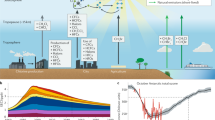Abstract
HALONS H-1301 (CBrF3) and H-1211 (CBrClF2) have been introduced into the atmosphere, mainly through use in fire extinguishers, for almost three decades. Although each is now present in the troposphere at a concentration of only 2 parts per 1012, these gases have long atmospheric lifetimes (65–77 yr for H-1301 and 11–16 yr for H-1211)1,2 and carry significant amounts of bromine to the stratosphere2,3, where it can destroy ozone catalytically4,5. For this reason, the halons have high ozone depletion potentials6. The manufacture of both gases is to be discontinued globally by the year 2000, according to the Montreal Protocol, and perhaps sooner, as a result of unilateral action by users, manufacturers and producing countries7,8. Here we present a six-year record of tropospheric halon mixing ratios which shows that the growth rates of H-1301 and H-1211 have already begun to decrease substantially. This recent decrease in growth rates is consistent with industry emission estimates (although these have greater uncertainties), and supports current appraisals of atmospheric lifetimes. Our results suggest that, even though these halons are relatively long-lived species, their atmospheric mixing ratios may stabilize or begin to decrease within the next few years.
This is a preview of subscription content, access via your institution
Access options
Subscribe to this journal
Receive 51 print issues and online access
$199.00 per year
only $3.90 per issue
Buy this article
- Purchase on Springer Link
- Instant access to full article PDF
Prices may be subject to local taxes which are calculated during checkout
Similar content being viewed by others
References
Burkholder, J. B. et al. J. geophys. Res. 96, 5025–5043 (1991).
Prather, M. J., Ibrahim, A. M. A., Sasaki, T., Stordal, F. & Visconti, G. in Scientific Assessment of Ozone Depletion: 1991, Global Ozone Res. Monitoring Proj. Rep. 25 (eds Watson, R. T. & Albritton, D. L.) (World Meteorological Organization, Geneva, 1992).
Salawitch, R. J., Wofsy, S. C. & McElroy, M. B. Planet. Space Sci. 36, 213–224 (1988).
Anderson, J. G., Brune, W. H., Lloyd, S. A., Toohey, D. W. & Sander, S. P. J. geophys. Res. 94, 11480–11520 (1989).
McElroy, M. B., Salawitch, R. J., Wofsy, S. C. & Logan, J. A. Nature 321, 759–762 (1986).
Solomon, S., Mills, M., Heidt, L. E., Pollock, W. H. & Tuck, A. F. J. geophys. Res. 97, 825–842 (1992).
Montreal Protocol to Reduce Substances that Deplete the Ozone Layer Report, Final Report (UNEP, 1987).
Bryk, D. S. Harvard Envir. Law Rev. 15, 275–298 (1991).
Butler, J., Elkins, J. W., Thompson, T. M., Hall, B. D. & Brunson, C. M. in Geophysical Monitoring for Climatic Change No. 17, Summary Rep. 1988 (eds Elkins, J. W. & Rosson, R. M.) 64–70 (U.S. Dept of Commerce, NOAA/ERL, 1989).
Zielinski, W. L., Hughes, E. E., Barnes, I. L., Elkins, J. W. & Rook, H. L. DOE Tech. Rep. TR033-74 (U.S. Dept of Energy, Washington DC, 1986).
Prather, M. P., McElroy, M., Wofsy, S., Russell, G. & Rind, D. J. geophys. Res. 92, 6579–6613 (1987).
Weiss, W., Sittkus, A., Stockburger, H. & Sartorius, H. J. geophys. Res. 88, 8574–8578 (1983).
McCulloch, A. Atmos. Envir. A26, 1325–1329 (1992).
Lal, S., Borchers, R., Fabian, P. & Krüger, B. C. Nature 316, 135–136 (1985).
Singh, O. N., Borchers, R., Fabian, P., Lal, S. & Subbaraya, B. H. Nature 334, 593–595 (1988).
Moore, C. A. Ambio 19, 320–323 (1990).
Pallavicini, M. Electr. Data Process. Audit, Control, and Security Newsl. 19, 1–7 (1991).
Floden, J. R. & Nimitz, J. S. in Proc. Air and Waste Management Assoc., 84th Mtg. Exhibition (Air Waste Manage. Assoc., Pittsburgh, Pennsylvania, 1991).
Mellouki, A. et al. Geophys. Res. Lett. (in the press).
Megie, G. et al. in Scientific Assessment of Stratospheric Ozone: 1989, Global Ozone Res. Monitoring Proj., Rep. No. 20 (World Meteorological Organization, Geneva, 1990).
Grosjean, D. J. Air. Waste Manage. Assoc. 41, 56–61 (1991).
Cicerone, R. J., Heidt, L. E. & Pollock, W. H. J. geophys. Res. 93, 3745–3749 (1988).
Prather, M. J. & Watson, R. T. Nature 344, 729–734 (1990).
Hammitt, J. K. et al. Nature 330, 711–716 (1987).
Singh, H. B., Salas, L. J. & Stiles, R. E. J. geophys. Res. 88, 3675–3683 (1983).
Khalil, M. A. K. & Rasmussen, R. A. Antarct. J.U.S. 20, 206–207 (1985).
Ehhalt, D. et al. Rep. Int. Ozone Trends Panel, 1988, Global Ozone Res. Monitoring Proj. Rep. No 18 (World Meteorological Organization, Geneva, 1989).
Butler, J. H., Elkins, J. W., Thompson, T. M. & Egan, K. B. J. geophys. Res. 94, 14865–14877 (1989).
Author information
Authors and Affiliations
Rights and permissions
About this article
Cite this article
Butler, J., Elkins, J., Hall, B. et al. A decrease in the growth rates of atmospheric halon concentrations. Nature 359, 403–405 (1992). https://doi.org/10.1038/359403a0
Received:
Accepted:
Issue Date:
DOI: https://doi.org/10.1038/359403a0
This article is cited by
-
A critical review of the successful CFC phase-out versus the delayed methyl bromide phase-out in the Montreal Protocol
International Environmental Agreements: Politics, Law and Economics (2010)
-
Present and future trends in the atmospheric burden of ozone-depleting halogens
Nature (1999)
-
Satellite confirmation of the dominance of chlorofluorocarbons in the global stratospheric chlorine budget
Nature (1996)
-
Decrease in the growth rates of atmospheric chlorofluorocarbons 11 and 12
Nature (1993)
Comments
By submitting a comment you agree to abide by our Terms and Community Guidelines. If you find something abusive or that does not comply with our terms or guidelines please flag it as inappropriate.



